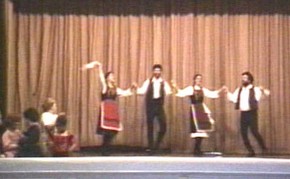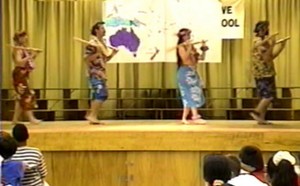 Dances From Around the World | The Gypsy Folk Ensemble presented its first school assemblies in 1982. Since that time, working with various arts organizations, including Performing Tree and the Arts Community Partnership Network (ACPN), Gypsy has brought more than 1500 school assembly programs to over 800 schools in the Los Angeles Unified School District (LAUSD) and other schools, public and private, in the Southern California area. In 2017, Gypsy began a new chapter with the LAUSD as one of the participating artists in the Arts Community Network (ACN) program to help bring dance art education to children in high-need schools. |  Echoes of Polynesia |
School Assembly Programs in Dance
The Gypsy Folk Ensemble presents a choice of six different international world dance assemblies which are suitable for all grade levels. All shows feature four dancers in authentic costume and include audience participation and an educational narrative. The programs, which emphasize cultural diversity, are designed to introduce students to the art of dance, to foster an appreciation of other cultures, and to encourage the concept of arts education as part of the core curriculum in schools. All performers and teaching artists are professional dancers with extensive experience in children's dance education and school assembly performances. Materials for the assemblies include a written Resource Guide with pre- and post-performance activities and suggestions for further study. Our standard fees are $775 for a single 45 minute assembly, $1300 for two assemblies at the same site, and $1800 for three assemblies.
Add other components
Arts education has been shown to have a positive influence on school attendance and the achievement gap, so if it is financially feasible, we encourage schools to expand their arts instruction by incorporating Student Workshops and Professional Development in addition to assembly programs. Gypsy also offers a Dance Package as a comprehensive solution for developing dance education in schools and bringing active participation in dance to students and teachers. We can adapt our material and presentation to suit your school's curriculum and budget. Please contact us to discuss your school's particular needs.
Where we perform
Gypsy works in public and private schools throughout Southern California including Los Angeles, Ventura County, Orange County, Riverside, San Bernardino and San Diego. In Santa Barbara and San Luis Obispo counties, we do our booking through the Children's Creative Project as a Touring Artist in Dance. The company also occasionally makes tours to the San Francisco Bay area and elsewhere in California and the Southwest United States - contact us for more information on tour schedules and fees.
Our Assembly Programs < Use the arrows to cycle through the pictures >
Dances From Around the World consists of three suites of dances which center around typical folk activities in Eastern Europe and the Middle East.
We begin with a visit to a village in Romania where we arrive just in time to see several dances at the social and dance occasion called the Sunday Hora. We then travel far south to the Middle East where we join a Hafli, or Arabic house party, where the guests take part in a variety of Arabic dances. Our journey ends at a Greek Taverna where we watch the local people do some popular Greek dances.
Students are invited to learn a simple Greek dance, and the show concludes with the dance to the familiar music of "Zorba the Greek".
Pictures from the Past explores the contributions made to American popular culture, music, and dance by nineteenth and early twentieth century European immigrants.
We focus on three groups of immigrants: the Italians in early California, the Irish on the East Coast, and the Germans of the Midwestern United States. Among other dances we see the Italian Tarantella, the Irish Reel, and the German Laendler (a precursor to the waltz). Everyone joins in to perform the famous Chicken Dance from Germany.
We learn that these immigrants brought us such things as the hot dog and Christmas Tree from Germany, Halloween customs such as the Jack o' Lantern from Ireland, and pizza as well as the vegetable and wine industry of California from Italy.
Roots of American Dance traces the origin of our traditional American dances.
We begin in the Eastern United States with the British and Irish influences on country dances in the original American Colonies. Our second suite takes us Down South to the city of New Orleans where Canadian French, African-American, and European dance styles have been merged to form a new type of Cajun and Zydeco dancing.
Lastly we travel to the Southwest and the Rio Grande border area to look at the European and Mexican sources of such cowboy dances as the schottische and polka in Texas and Arizona.
Students are invited to join in and come on stage to learn Cotton-Eyed Joe, one of the most popular of all cowboy dances.
Echoes of Polynesia presents a selection from the rich and varied cultures of Polynesia and shows how music and dance have been shaped by the island environment.
We start in the far north of the Polynesian Triangle in our 50th state, the Hawai'ian Islands, with several versions of the familiar Hula, including one that the students learn while seated in the audience.
Next is a trip across the Pacific to learn about a different style of life and dance among the Maori people of New Zealand. We conclude the program with a visit to Tahiti where we have students come on stage to learn a traditional Tahitian dance. Authentic musical instruments and costumes are used throughout the performance to stress the importance of natural resources in the life of the Pacific peoples.
Mexican Mosaic examines part of the collection of customs and traditions which together make up modern Mexican culture.
We look at the influences, both native and from abroad, which have shaped Mexican music and dance. These range from the elaborate Flamenco footwork and stamping patterns of Spanish Gypsies to the polkas and waltzes brought by early German immigrants. The show includes a wide variety of Mexican dance from the Texas border to the southernmost state of Chiapas.
Students also learn a typical Mexican dance with a surprising ancestry. The program is especially appropriate for Cinco de Mayo but is available throughout the year.
Holidays with Gypsy gives a glimpse of California's rich multicultural heritage as it explores the December holiday customs of several cultural groups.
The show begins with the Mexican-American tradition of Las Posadas. We then investigate the background and practices of the eight day Jewish holiday of Hanukkah, the "Festival of Lights". We continue by searching out the California roots of the African-American holiday and cultural celebration of Kwanzaa and end the show with a look at the Central European sources of many of our Christmas customs such as the Christmas Tree and Santa Claus.
The dances presented include folklorico dances from Mexico, the Jewish Hora, and Austrian and German dances. We also have students join us to learn a West African dance.